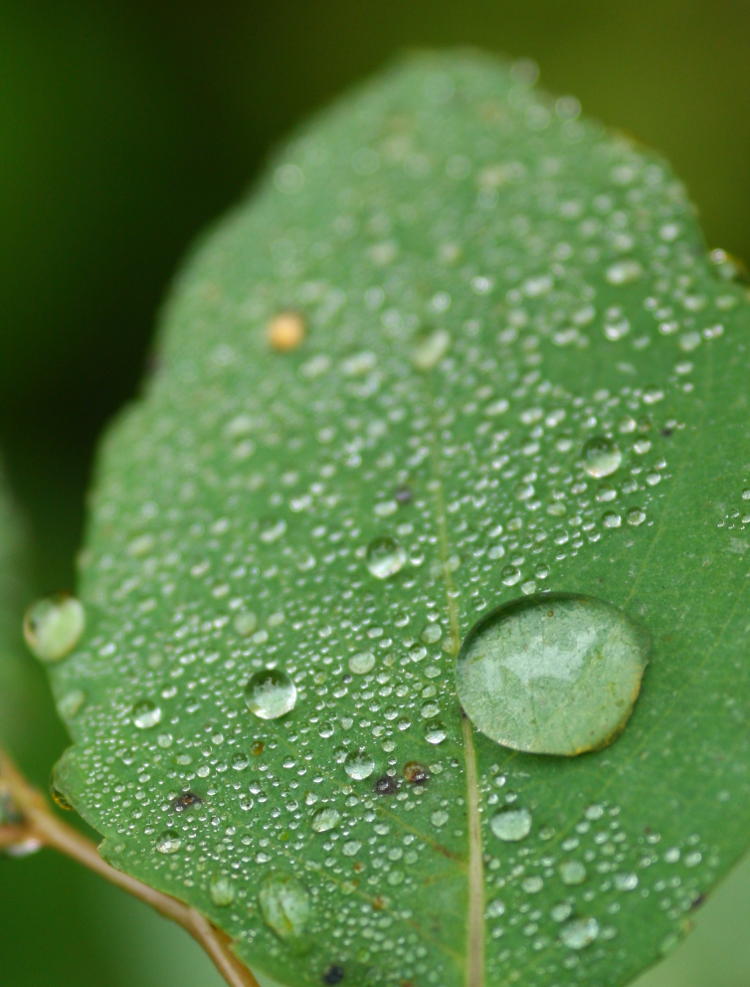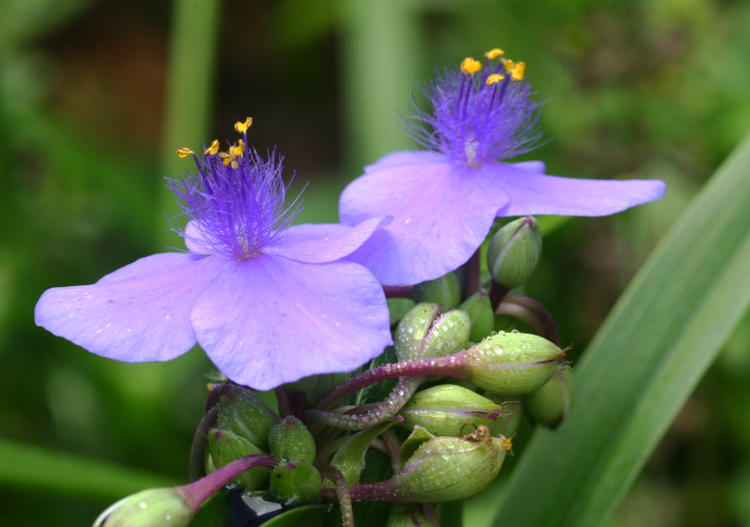
A month ago, I commented on an outing to the NC Botanical Garden where I didn’t really achieve much; this time around, I did notably better, even when still not seeing some of the subjects that I was hoping to. Naturally you can’t plan on finding particular subjects – if you could there’d be no challenge to it – but you can aim for them at least, choosing the best conditions and all that, yet you’ll still have to take it as it happens, and find other things to make the trip worthwhile. Above, I just happened to like the two hairy-stem spiderwort blossoms (Tradescantia hirsuticaulis, I think anyway) with the dew on the buds beneath, and used the soft light of the near-overcast conditions.
Overall though, I’m not much of a flower and plant photographer, so garden visits are aimed more towards arthropods and reptiles and all that, which were a little scarce. Or I’m not on top of my game as much as I think I am, but we’re not going to devolve into existentialism right now. There are still plenty of things in bloom, and those were attracting not just the things that feed on them, but the things that feed on the things that feed on them, and I did manage to scare up a few of those. On the same variety of phlox as that previous linked post, I spotted a very small crab spider trying to be subtle enough to escape the attentions of any blundering pollinator (that was the right size, at least.)
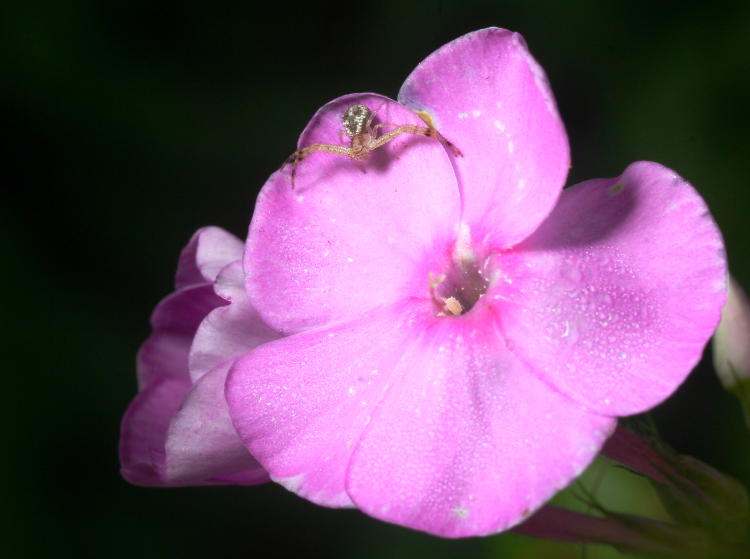
Given that the flower was less than 20mm across, you can imagine the size of the spider itself, but this one was much bigger than several of its relatives that I found in another section, hanging out on the black-eyed Susan flowers (Rudbeckia hirta.)
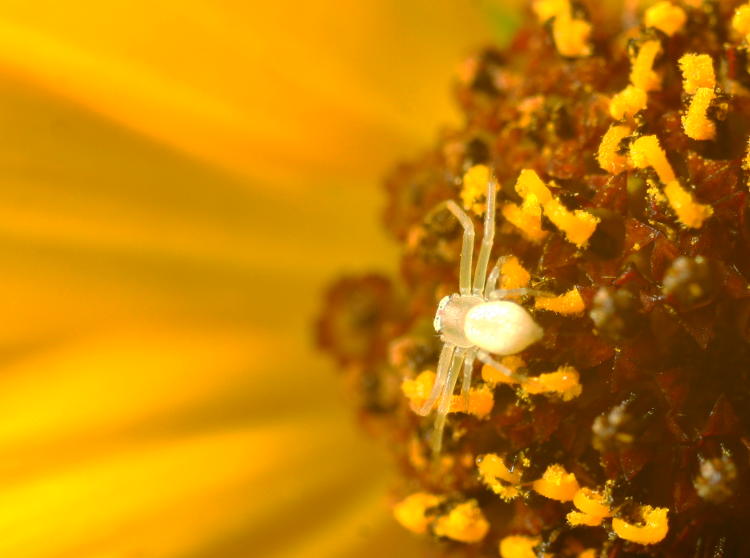
I’d made a small mistake, in that I didn’t pack an extra set of batteries for the macro flash rig and they were pegging out here, so I only had a couple of tries at this with a lot of time in between (or at least, a lot of time when you’re looking at a subject and waiting for the flash to recharge from nearly-depleted batteries, which means maybe two minutes.) After this, I simply went with existing light, but I did at least snag a frame with enough detail to show off the eentsy occupant – for which we now have to back off a bit to illustrate just how visible it actually wasn’t.
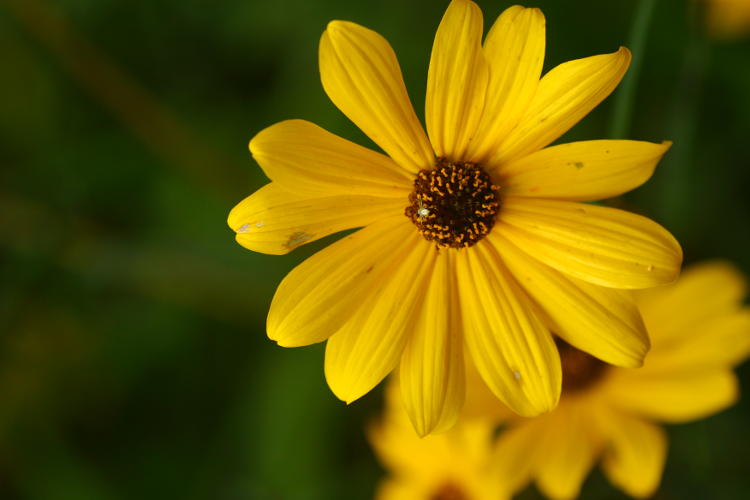
If you’re not familiar with black-eyed Susan blossoms, they’re about 50-70mm across, a little smaller than the width of your palm. But they virtually never produce pale whitish spots in the center, so that’s the cue to look closer if you see one. I spotted several of these spiders, all in the same general vicinity, which led me to believe there was likely a hatching nearby, but I didn’t see any with prey, which is a shame because I really wanted to see what they could eat at that size. Given how adept crab spiders are, however, it’s quite possible they could tackle my next subject easily.
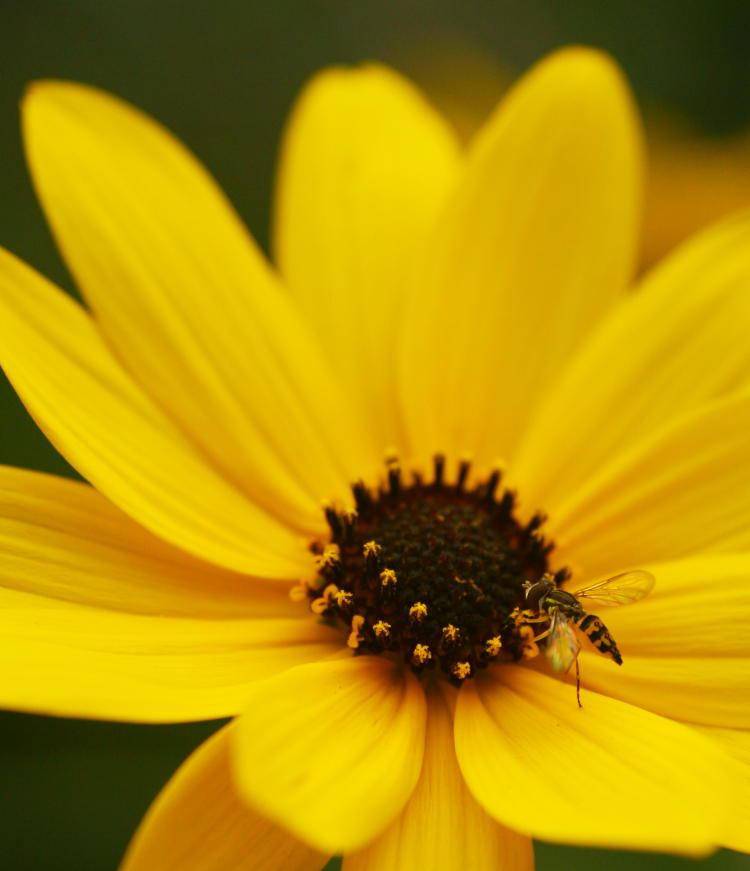
This patch of flowers was a little removed from the previous yet there were no crab spiderlings to be found, so the hoverfly could partake of that sweet, sweet nectar (so I’m told, anyway) without risk. There were a lot of hoverflies around, but it took a few attempts before I found one that was tolerant/oblivious/stupid enough to let me lean in close enough for the shot, and got a little iridescence off of the wings for my trouble.
That’s enough yellow – how about a bit more blue?
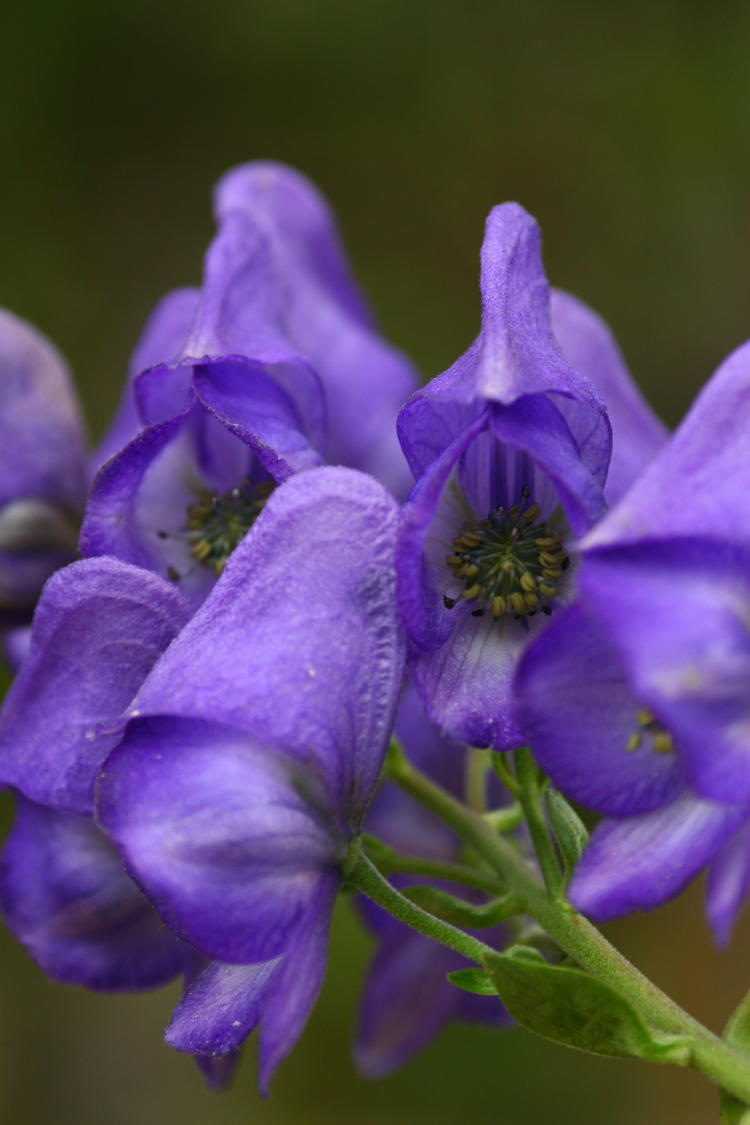
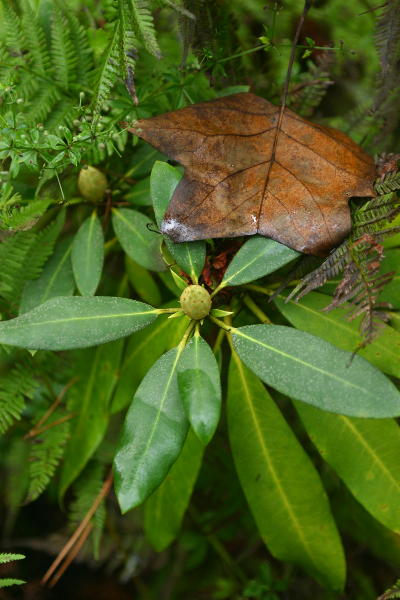 The Aconitum blossoms above go by a variety of names, and one of them is ‘monkshood’ – when we choose that one, this now seems to have a faintly accusatory feel to it, as if we’ve just caught the eyes of the monks from across the monastery while doing something unmonkish (which is just about everything, I think.) Or maybe that’s just me.
The Aconitum blossoms above go by a variety of names, and one of them is ‘monkshood’ – when we choose that one, this now seems to have a faintly accusatory feel to it, as if we’ve just caught the eyes of the monks from across the monastery while doing something unmonkish (which is just about everything, I think.) Or maybe that’s just me.
Meanwhile, I chanced across the composition at right and just liked it, though I couldn’t really tell you why (it’s on a need-to-know basis, and you don’t need to know,) but here it is anyway. Feel free to do all the Rorshaching that you like over these peeks into my psyche.
I will note that all of the moisture visible, despite the hints provided by the muted light, came from overnight dew, not rain. A little later on in the day it did rain, but not until I’d done all of the shooting that I’d wanted to and left, so my timing was down for that at least.
On the side of one of the small ornamental ponds – the same as this one, actually – sat a pair of green frogs (Lithobates clamitans) mostly screened by the surrounding plants, and I endeavored to capture them both in the same frame.
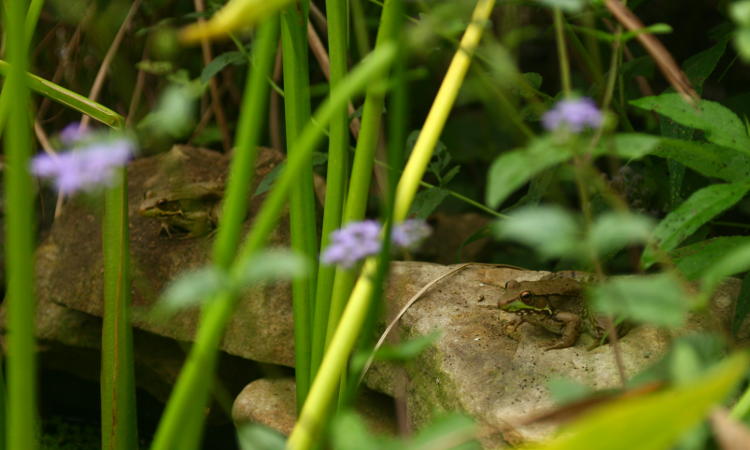
It was challenging getting the right angle to see their eyes, requiring a very specific vantage through the plants, and depth of field probably wasn’t going to get high enough for the sharpness of both in that light, but upon unloading the memory card I found that it almost looks like there’s only one frog, with a mirror in the bushes. Or maybe there really was a mirror and I simply missed it. Maybe I only thought I was in the botanical garden.
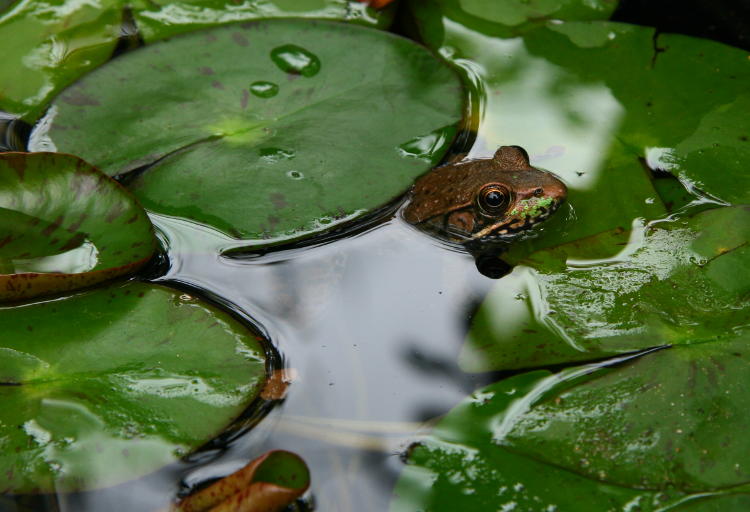
In a nearby section, another green frog had been perched fetchingly on the rim of a wooden barrel turned pond/planter, but dove into the water the moment that I started centimetering closer. I waited patiently for a little less than two minutes and it resurfaced, but submerged again with the slightest twitch of the camera. Making another pass about twenty minutes later, I found it floating again and this time managed to creep quite close, firing off frames the entire time. From some angles, the water reflected the blue-grey sky and added a little more character to the frame, which is what I went with here. And I have to note that I cropped out both the edge of the barrel and an identification signpost rising from the middle of the tiny pond, one of the hazards of shooting in a maintained garden.
I was pleased to see this next one, though.
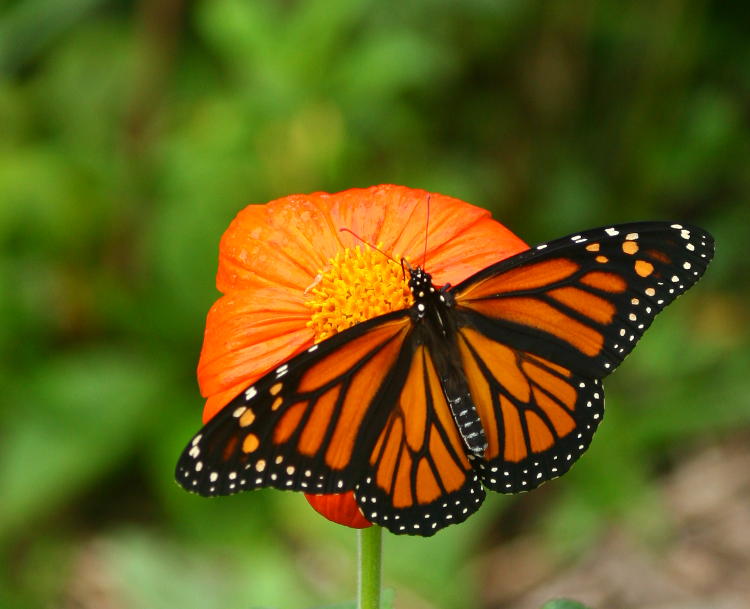
While monarchs (Danaus plexippus) are considered the most common butterfly in North America, they certainly aren’t around here, and I’ve barely seen them in the past several years – they’re outnumbered hugely by the swallowtails. This one was being exceptionally shy; while it was feeding openly on a patch of chrysanthemums, it didn’t like me creeping closer and flew off multiple times as I drew in for more detailed shots.
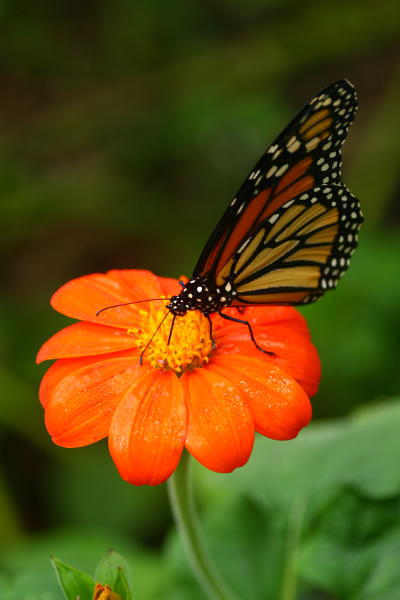 Eventually, it settled in on a bloom that was a bit closer to me, and ignored my approach, so I was able to get in much closer and get the detail that I was after. Once again, I think the muted light helped; it’s easy to believe that bright light is better for colors, but the truth is, bright light increases contrast and makes the shadows seem deeper while it can wash out the colors at times, so hazy to overcast light is actually better for such colorful compositions. And of course, bright sunlight would have burned away all of the dew by this time, eradicating an element that I was making good use of this trip.
Eventually, it settled in on a bloom that was a bit closer to me, and ignored my approach, so I was able to get in much closer and get the detail that I was after. Once again, I think the muted light helped; it’s easy to believe that bright light is better for colors, but the truth is, bright light increases contrast and makes the shadows seem deeper while it can wash out the colors at times, so hazy to overcast light is actually better for such colorful compositions. And of course, bright sunlight would have burned away all of the dew by this time, eradicating an element that I was making good use of this trip.
The image at right is the full frame, while below is a detail crop from the same frame, showing off what I captured (because that’s what a blog is for.) I’m just a little disappointed that I caught the proboscis (‘siphon’) in such a straight line, abruptly disappearing deep within the flower instead of showing a nice sine curve as is often the case.
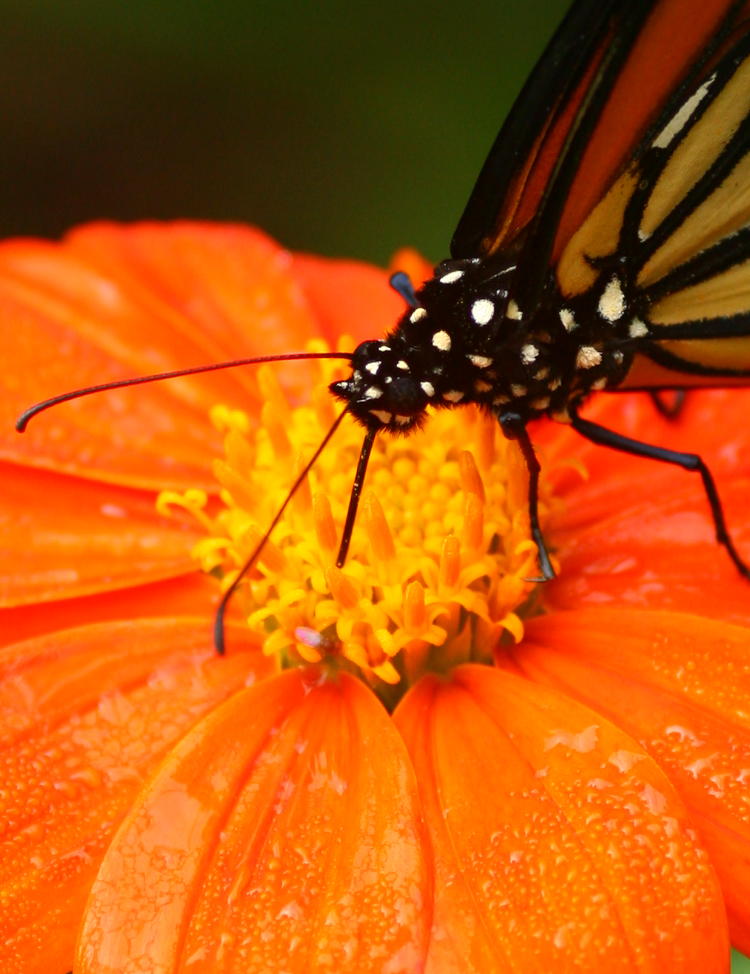
But wait, what’s that? Right there, below the proboscis. I certainly never saw it as I was shooting, but there’s another tiny fly, perhaps even too small for those crab spiders to make a meal of, hanging out on the same flower – see the little patch of pink and blue from the iridescent wings? It looks further out of focus than its surroundings, so I suspect it was actually starting to take flight in this image, blurring slightly in the 1/400 second shutter speed. Yes, I’m sure it was a fly, because it shows in other frames as well.
And one last shot for posterity, because you know I like this kind of photo. I’m thinking something might have bumped the leaf on the right side, causing the dew to combine into that larger drop, but it might simply have been the curve of the leaf. Whatever – it lends a little asymmetry to the shot and provides a focal point. I like it, anyway…
